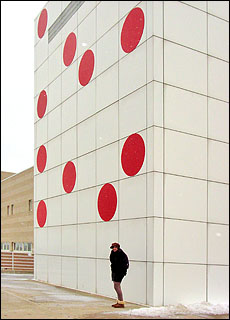Archives
Red dots raise campus awareness
Student’s ’one-in-five’ project communicates prevalence of genital herpes
By KEVIN FRYLING
Reporter Staff Writer

Jacquelyn De Jesu stands at the west
wall of the Center for the Arts, one of the sites on the North Campus
for her "one-in-five" campaign to raise awareness among UB
students of the prevalence of genital herpes among college students.
PHOTO: KEVIN FRYLING
Members of the university community returned to the North Campus after the Thanksgiving break to see a rather unusual site at the east end of campus: large red dots on the white tiles on the west side of the Center for the Arts near Slee Hall.
The mystery of the red dots was revealed on Monday when Jacquelyn De Jesu, a senior majoring in advertising art direction, began passing out flyers. The message: One in five people in the United States is living with type-2 genital herpes.
“When I heard the statistic, it shocked me,” De Jesu says about the inspiration for her “one-in-five” awareness campaign. According to the Centers for Disease Control and Prevention, young people ages 20-29 are now twice as likely to have a type-2 herpes infection than in the late 1970s, she says. “As I was talking to friends,” she adds, “I realized that a lot of people had no idea about the virus or how it’s transmitted.”
De Jesu developed and implemented the campaign under the direction of Benjamin Van Dyke, assistant professor in the Department of Visual Studies, College of Arts and Sciences, in order to raise awareness about an important issue, as well as fulfill the final project requirement of her major. The campaign, which began Nov. 26, will run until Saturday.
De Jesu explains that not enough college students are taking precautions against the herpes viral infection due to inadequate awareness about the disease’s prevalence. She also notes that few seem to realize that cold sores—which affect between 80 to 90 percent of all Americans at some point in their lives—are a form of herpes that can spread between sexual partners and develop into more serious forms of the infection through unprotected oral contact.
“I feel like it’s just not talked about as much as other sexually transmitted diseases—and I don’t know why that is because it’s so common,” says De Jesu, noting that since no treatment exists to cure herpes, individuals with the infection must learn to live with it. “If you’re infected, it’s something that you’re going to have to talk to your partner about every time you start getting into a serious relationship.”
The red dots not only appear on the side of the CFA, but also on one in five chairs, steps and floor tiles in various lecture halls, stairwells and hallways in Norton and Knox halls, as well as in the Natural Sciences Complex and the Student Union. Also sporting the spots are every fifth seat, computer desk and 15-minute work station in Capen Library. A total of 500 to 600 red dots appear in these high-traffic areas across the North Campus.
De Jesu says she choose these “guerrilla advertising” techniques to communicate the prevalence of type-2 herpes because she believes students have begun tuning out messages about sexually transmitted disease after years of hearing them from parents, teachers and counselors from middle school through college. She says creating buzz about mysterious red dots on campus before revealing the significance behind the numbers “one-in-five” is a means to impress an important statistic on people before they’re able to ignore it.
“I think the title of the campaign and putting it in places that are so visual has enabled people to absorb the message before having a knee-jerk reaction to it being about herpes—because many people shut off as soon as they realize that,” she says. “Everyone talks about STDs and safe sex on college campuses, and we always hear it the same way. To approach it from such a different perspective has really grabbed people’s attention.”
The visual nature of the project also offers a higher-impact dissemination of the message than a traditional awareness campaign, De Jesu adds, noting that a crowded lecture hall in which 60 out of 300 chairs feature a red dot illustrates the high risk of infection in the real world.
“When you look around and see so many red dots, it’s harder to ignore,” she says, “It’s easier for people to comprehend, even if they’re not [consciously] paying attention.”
